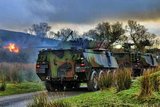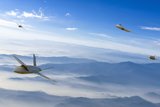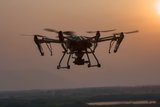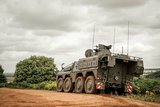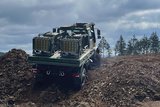Enhancing electronic support to achieve spectrum dominance within multi-domain operations (sponsored)
This article is brought to you by Roke.
The rise of wide area networking, mobile communications and automation across civilian and defence applications, means key sections of the electro-magnetic spectrum are highly congested and, from a military perspective, increasingly contested.
This growth is likely to be sustained through the proliferation of devices exploiting digitally enabled functionality through automation, internet of things and space-based data services.
So what are the key challenges in today’s congested and contested EMS environment?
Within the EME, the density of real and apparent targets together with active attempts to spoof, confuse or defeat communications is a concern. Recent reviews have highlighted that China and Russia are both focussed on spectrum exploitation, with the latter said to have a capability lead in ground-based electronic warfare.
In a congested EME, identifying sources of interest reliably can also prove challenging with operators needing to separate and identify the components quickly and precisely.
Given the importance of the EME, it is crucial that EW units are equipped to counter these threats by deploying modern sensors which deliver great insight and analysis with reduced vulnerability and maximum operational flexibility.
How can technology solve the problems of congested and contested EMS environments?
The starting point in countering EME threats is to enable operators to interpret emitter characteristics rapidly and accurately. The use of Adaptive Digital Beamforming (ADBF) overcomes this problem by allowing the sensor or array to focus on specific targets of interest, increasing gain or steering a null onto unwanted interferers, intentional or otherwise.
In addition, identifying and characterising sources of interest reliably is increasingly dependent advanced analytical tools. Super Resolution Direction Finding (SRDF), enables the operator to ‘see’ through a congested RF environment to resolve specific transmissions. Even where multiple sources operate on the same frequency and in high multi-path environments, the operator can resolve a threat or target decisively.

What key features can enhance electronic support capability?
- Maintaining Awareness of Position
- Low Size, Weight and Power (SWaP)
- Countering digital and agile threats
- Supported by high performance software
EW Support sensors require accurate positioning information to determine source location and typically use GNSS services for this purpose. This dependency introduces a vulnerability to denial of service or spoofing attacks. Russia has demonstrated proficiency in these techniques, with publically documented instances of both being employed in recent grey zone conflict and low level confrontations. Modern EW Support sensors address this issue through dual GNSS compassing and inertial positioning enhanced by use of on-board magnetometers.
To deliver maximum tactical flexibility, improvements in modern antenna design and electronic performance are exploited to drive down size, weight and power characteristics and to simplify connectivity. With advanced design, the sensor head can achieve most processing on-board and requires only a single fibre optic cable to provide both power and connectivity. An end user device (typically a laptop) is used for operator interface, enabling analysis/distribution. A highly integrated sensor head should also require minimal calibration and, with augmented position fixing, have no external data dependencies.

The design of electronic components and high density printed circuit boards continues to advance. Highly optimised wide-band antenna configurations coupled with the compute power available from advanced processors, now enable EWS sensors weighing as little as 10Kg and occupying less than 0.2m3 to deliver ADBF, SRDF, azimuth and elevation DF functionality from within the integrated sensor head. Such an advanced sensor can deliver high performance across a wide bandwidth and address a comprehensive range of target types. Reduced SWaP characteristics facilitate mast mounting of the sensor on a tactical vehicle.
The compute performance available within the sensor also supports processing of multiple simultaneous transmissions for off-board analysis/interpretation, supporting up to 64 Digital Drop Channels (DDC). A modern EW Support system can therefore provide an effective communications intelligence (COMINT) capability.
There is a growing need to counter asymmetric threats and contest grey zone operations. Adversaries in these operations are quick to exploit new commercial and commercial derived technologies and services. EW sensors must therefore be capable of dealing with sources that include digital mobile radio (DMR), cellular and satellite communications.
Advanced EW Support should also be effective against frequency hopping threats. Cluster algorithms and high performance processing analyse frequency dwell time and hop raster characteristics, overcoming such countermeasures and maintaining operational effectiveness.
The full operational lifecycle, from planning through operations to post mission debrief, analysis and training should be supported from a common software platform. Operators require an intuitive interface and flexible formats in order to be effective quickly with minimal training. Design principles for integrated, software driven, systems should therefore include:
- Integrated by Design: Platforms should be designed to operate seamlessly using core software suites for operational control/presentation and analysis/interpretation. Compatible systems should enable smooth connectivity/handoff to deliver operational effect in real time over chosen networks
- Interoperable through Open Standards: End to end solutions should integrate third party applications, radio heads and receivers with particular focus on vehicle integration via Modular Open RF Architecture (MORA), JICD 4.2 Common Services Mission Fabric and Raptor X
- Evergreen: Software components should use agile algorithm and coding development to iteratively deliver new features to customers. This allows customers’ emerging needs to shape the software development cycle and allows suppliers to deliver intuitive Graphical User Interfaces (GUIs) and workflows whilst utilising automation to reduce operator burden
- Support Operator Effectiveness: By minimising the number of software applications which are involved in managing across the spectrum, operator training is minimised and expertise evolves quickly
As we have explored in this article, the threat landscape is continually evolving and requires a proactive approach from defence and security forces. Industry is on hand to help with emerging requirements and Roke’s CEMA solutions are a generational advance in EW Support.
To continue the conversation, find out more or meet our experts, meet with us at EW Estonia Live or EW Europe; alternatively visit us at www.roke.co.uk
More from Industry Spotlights
-
![The future is here: Sixth-gen air dominance]()
The future is here: Sixth-gen air dominance
How RTX is equipping the military airspace – for today’s fleet and tomorrow’s fight.
-
![De-Risking the Future: Manufacturing Certainty for Unmanned Systems]()
De-Risking the Future: Manufacturing Certainty for Unmanned Systems
How strategic manufacturing partnership solves the industrialisation triad — Scale, Compliance and Cost — for hyper-growth defence tech innovators.
-
![Battlefield mobility, made in the UK]()
Battlefield mobility, made in the UK
How does Britain ensure that we can preserve the lives of our soldiers and allies – now and in the future – with homegrown innovation and resilient domestic manufacturing? At Pearson Engineering, we are proud to be a central part of the answer to this increasingly important question.
-
![Strengthening Baltic defence capabilities]()
Strengthening Baltic defence capabilities
How Latvia is bolstering its territorial defences, industrial capacity and international cooperation with Dynamit Nobel Defence’s SKORPION2 Remote Mining System.
-
![Barco’s vision to trust: from past to future]()
Barco’s vision to trust: from past to future
Barco’s story is one of constant evolution enabling more immersive, reliable, and future-ready training experiences.
-
![How are next-generation ejection seats helping pilots when they need it most?]()
How are next-generation ejection seats helping pilots when they need it most?
The ACES 5 ejection seat from RTX’s Collins Aerospace introduces new, innovative and patented technologies to help save lives.













